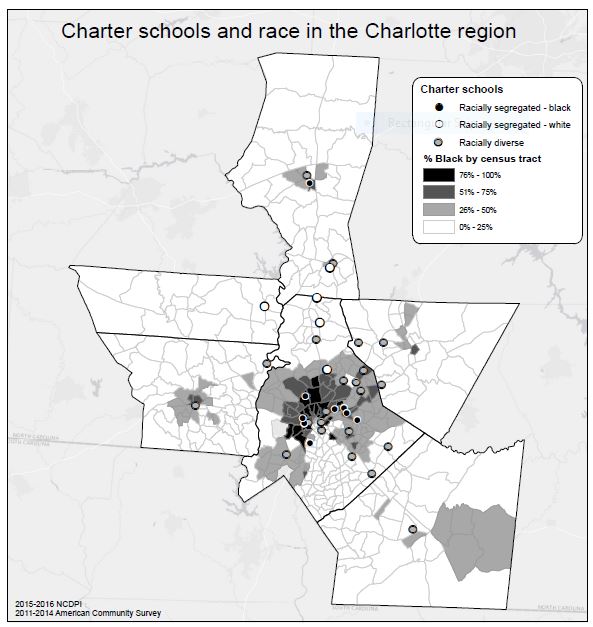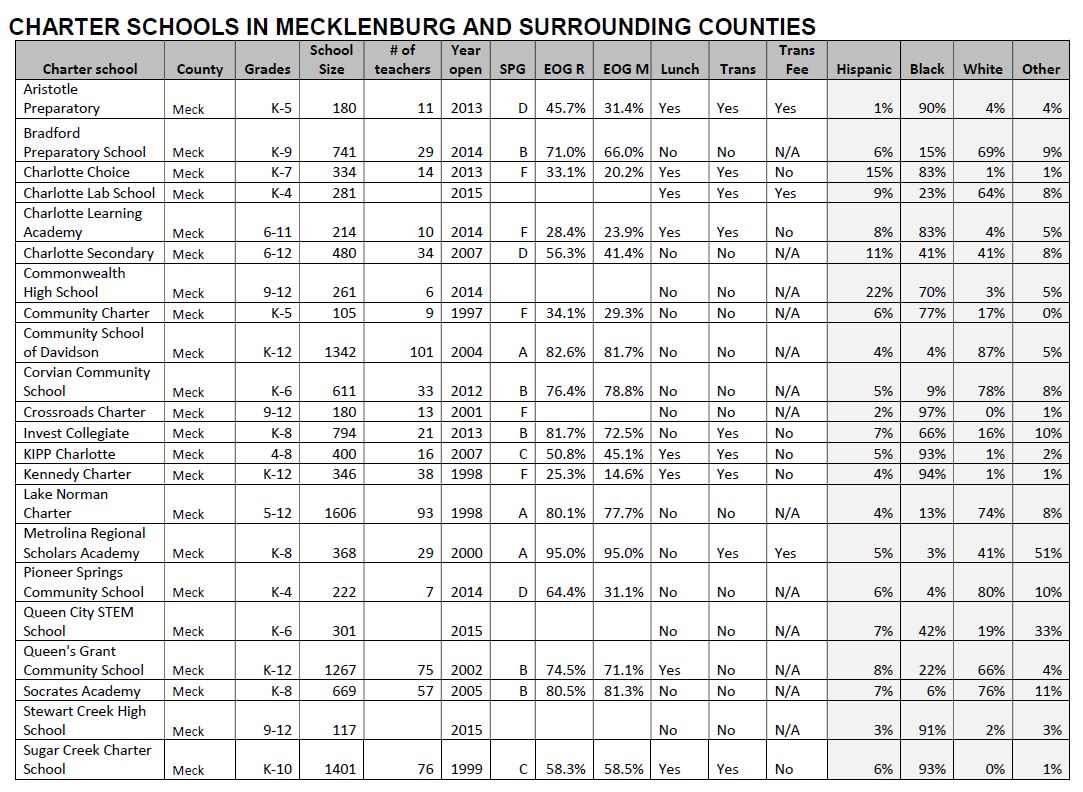As charters and choice expand, so does segregation

As charter school enrollment has more than doubled across the U.S. over 10 years, demographic data are showing that charter schools are more segregated than traditional public schools.
Nationally, 2.5 million students were enrolled in charter schools in 2013 across the U.S. Just 10 years prior, enrollment was less than 1 million.[1] Despite that growth, research has been inconclusive on the question of whether charter schools and school choice in general are effective in improving student outcomes.[2] What is clear is that charter schools are more segregated – 39 percent of charter schools have concentrated poverty compared to 24 percent of traditional public schools.[3]
AS CHOICE PROGRAMS EXPAND, SO DOES SCHOOL SEGREGATION
While the research surrounding academic outcomes of school choice remains unclear, there is evidence that without equity-oriented safeguards – such as access to information, transportation, and equitable admissions criteria – the expansion of school choice, including charter schools, corresponds with increased segregation by race, class, language and ability.[4] This segregation is largely due to parental choice.
Click on map to download a larger image. Map: Zach Szczepaniak
“School choice” generally refers to parental choice in school selection, either through magnet programs, attending charter schools, private schools, using government-paid vouchers to attend private schools, homeschooling or residential choice. Supporters of public school choice programs (such as charters and vouchers) say they can let parents escape an inadequate public school and that competition can push traditional public schools to improve.
Race and socio-economic status are key predictors for whether parents will exercise choice, with white, affluent families disproportionately more likely to use all forms of school choice.[5] Low-income parents have less access to information about choices as well as financial resources, and are less likely to actively choose schools.[6] During the school choice process, parents generally prioritize proximity and academic achievement. More affluent families typically have greater access to high quality schools close to home.[7] Many parents also seek schools where their children will be part of the racial majority.[8]
Data from communities across the United States indicate that as more parents choose schools, the number of segregated schools has increased.[9] Most importantly, this unrestrained school choice leads to deepening of the existing inequalities of outcome and opportunity among groups of students.[10]
DEMOGRAPHICS CHANGE, BUT ACHIEVEMENT GAPS PERSIST
The Charlotte region has undergone a dramatic demographic shift in the past 25 years as Mecklenburg County’s population has more than doubled since 1990. Part of the growth can be attributed to the population explosion of the Hispanic community, from 1.3 percent of the county in 1990 to 12.7 percent in 2014. As of 2015, 48.3 percent of the Mecklenburg County population was non-Hispanic white, but only 39.1 percent of school-aged children in Mecklenburg County fell into this category.[11]
Charlotte-Mecklenburg Schools is the second largest district in North Carolina and 18th largest in the country. In 2015-2016, 40 percent of students were black, 29 percent white, 22 percent Hispanic (CMS does not report race and ethnicity separately), 6 percent Asian, and 3 percent American Indian/multiracial.[12]
CMS remains the most racially and socio-economically segregated school district in the state,[13] with:
- 1 in 3 CMS schools segregated by poverty (80 percent or more of students qualify for free/reduced lunch).
- 1 in 2 segregated by race (80 percent or more are students of color).
- 1 in 6 CMS schools racially imbalanced white (60 percent or more are white, which is double the overall CMS proportion of white students).[14]
Differences among the outcomes of students attending schools are stark: The most racially and socio-economically segregated high school in the district had a graduation rate of 76.9 percent for 2014-15, compared to the most racially and socioeconomically isolated white and affluent school in the district, which had a graduation rate of 95 percent.[15]
Inequitable outcomes are visible across the district. In 2015, 93.8 percent of white students in CMS graduated compared to 86.8 percent of their black peers and 79.6 percent of Hispanic students.[16] Academic performance at all levels follows the same trend: White student proficiency rates on end-of-grade and end-of-course exams are double the rate of Hispanic and black student proficiency.
The district has experienced a persistent achievement gap coupled with shifting demographics and shifting rates of traditional public school attendance. In 1995-1996, approximately 1 percent of students were home-schooled, 87 percent attended CMS, and the remaining 12 percent were enrolled in private schools. In 2014-2015 approximately 4.2 percent of students were home-schooled, 80 percent attended CMS, 10.5 percent attended private schools, and 6 percent attended charter schools.[17]
HOW CHARTERS AND CMS INTERACT
In 2016, there were 25 charter schools in Mecklenburg County and 11 charter schools in surrounding counties that may serve students who live in Mecklenburg. In 2015-2016, 15,535 students attended charter schools in Mecklenburg County.
The first charter school opened in North Carolina in 1998, with a state-imposed cap of 100 schools statewide. The cap was lifted in 2011. By 2016-17, 168 charter schools were operating in the state.
In North Carolina, charter school enrollment is not bound by a student’s address. Charter schools do not receive funds for capital costs and are not required to provide transportation or a meal program.
While that funding structure may appear to provide an advantage to traditional public schools, in reality each student who attends a charter school decreases the amount of money a public school district receives from the state.
When students enter a charter school, money follows them from the district where they live to the charter they are attending on the 20th day of the school year. In 2015-16, charters received $25 million from CMS in pass-through funding. This is projected to be $30.9 million for 2016-17.[18] This funding pass-through occurs even though district operating costs remain mostly unchanged. Additionally, students can break their commitment to a charter school at any time, and charter schools have been known to shut down mid-year.[19] CMS receives former charter students with little notice, complicating enrollment projections and budgeting.[20] As a result, charters reduce the district’s funding. Less funding can lead to weaker instructional programs, which in turn threatens the quality of the district’s schools. This, in turn, undermines confidence among families who may respond to perceived deterioration in CMS by transferring their children to nearby charters.
OVERALL, CMS STUDENT OUTCOMES OUTSHINE CHARTERS
Enrollment in charters continues, though data suggest that, on a wide range of measures, outcomes of traditional public schools are typically higher. Examples:
In 2016:[21]
- 52 percent of CMS schools exceeded growth goals, versus 12 percent of charter schools.
- 14 percent of traditional public schools did not meet expected growth goals, versus 33 percent of charter schools.
Of the 14 charter schools in the region that serve 12th grade, 10 have had a graduating class. Of those:
- 7 schools have a four-year cohort graduation rate that exceeds the CMS average of 88.3 percent.
- 3 have a rate significantly lower (important to note that all three of those schools are hypersegregated schools of poverty and specifically serve students at risk of academic failure).
Of the 36 charter schools in the Charlotte region:
- 6 schools (17 percent) are hypersegregated and less than 2 percent of the student body is white.
- 14 schools (39 percent) are segregated by race (80 percent or more are students of color).
- 16 schools (44 percent) are racially isolated white (60 percent or more of students are white, which is double the district average).
- Not one charter school approximates the racial demographics of the community.
For more comparisons, see table:
Click image to download a larger view of table.
[1] National Center for Education Statistics. (2016). Charter school enrollment. [Graph last updated April 2016]. Retrieved from http://nces.ed.gov/programs/coe/indicator_cgb.as
[2] See: //story/what-studies-conclude-about-school-choice
[3] Kena, G., Hussar W., McFarland J., De Brey C., Musu-Gillette, L., Wang, X., Zhang, J., Rathbun, A., Wilkinson-Flicker, S., Diliberti M., Barmer, A., Bullock Mann, F., and Dunlop Velez, E. (2016). The condition of education 2016 (NCES 2016-144). Retrieved from U.S. Department of Education, National Center for Education Statistics website: http://nces.ed.gov/pubs2016/2016144.pdf
[4] Bifulco, Lass, & Ross, 2009; Lareau & Goyette, 2014; Mathis & Welner, 2016; Roda & Wells, 2013; Schneider, Tesk, & Marschall, 2000; Scott, 2005; Sikkink & Emerson, 2008; Smrekar & Goldring, 1999; Wells, Holme, Lopez, & Cooper, 2000
[5] Ball, Bowe, & Gewirtz, 1996; Brantlinger, Majd-Jabbari, & Guskin, 1996; Bifulco, Ladd, & Ross, 2009; DeJarnatt, 2008; Goldring & Hausman, 1999; Goldring & Phillips, 2008; Holme & Richards, 2009; Kimelberg, 2014; Loeb, Valant, & Kasman, 2011; Roda & Wells, 2013; Sikkink & Emerson, 2008
[6] Ball, Bowe, & Gewirtz, 1996; Holme & Richards, 2009; Lubienski, 2007; Palardy, 2013; Roda & Wells, 2013; Schneider, Tesks, & Marschall, 2000
[7] Bell, 2009; Cucchiara, 2013; DeJarnatt, 2008; Goldhaber et al., 2015; Reback, 2008
[8] DeJarnatt, 2008; Saporito & Lareau, 1999; Weiher & Tedin, 2002
[9] Bifulco, Ladd, & Ross, 2009; Brantlinger, Majd-Jabbari, & Guskin, 1996; Lareau & Goyette, 2014; Mathis & Welner, 2016; Roda & Wells, 2013; Schneider et al., 2000; Sikkink & Emerson, 2008
[10] Ben-Porath, 2010; Bifulco, Ladd, & Ross, 2009; Cucchiara, 2013; Lareau & Goyette, 2014; Palardy, 2013; Sikkink & Emerson, 2008
[11] United States Census Bureau. (2015). QuickFacts Mecklenburg County, North Carolina. Retrieved from http://www.census.gov/quickfacts/table/PST045215/37119
[12] Charlotte-Mecklenburg Schools. (2016). Fast Facts. Retrieved from http://www.cms.k12.nc.us/mediaroom/aboutus/Documents/CMS%20Fast%20Facts%20Sheet%202015-2016.pdf .
[13] Malkus, N. (2016). Differences on balance: National comparisons of charter and traditional public schools. American Enterprise Institute. Retrieved from https://www.aei.org/publication/differences-on-balance-national-comparisons-of-charter-and-traditional-public-schools/


